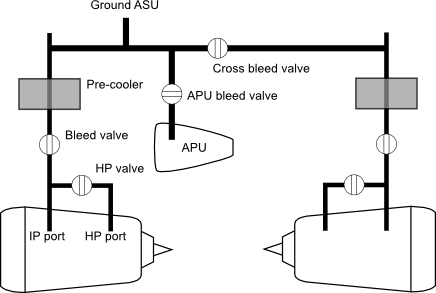The pneumatic system provides high pressure air for:
Air conditioning
Wing anti icing
Water pressurisation
Hydraulic resevoir pressurisation
Engine starting
The sources of air are:
The engines
The APU
High pressure gound air
Two Bleed Monitoring Computers, one per engine, control and monitor the pneumatic system. They are partially redundant, so in the event of a failed BMC, the other BMC can take over most of its functions.
Sensors in the vicinity of the hot air ducts detect leakage. If leakage is detected, the BMCs are signalled and they automatically shut down the affected area.
Engine bleed air is tapped at two compressor ports known as the Intermediate Pressure (IP) port and the High Pressure (HP) port. The HP port only provides air when the IP pressure is insufficient. The system automatically controls the delivery of air from the HP port using an HP valve.
The pre-cooler uses cold air from the engine to cool the bleed air.
The APU bleed air has priority over the engine bleed air. The engine bleeds valves will therefore remain closed whenever the APU bleen is ON.
The GND indication on the ECAM bleed page is always displayed on the ground, even if no ground HP unit is connected. Its purpose is solely as an indication as to where ground HP air would enter the system. The presence of ground HP air can be determined by examining the bleed pressures relative to attached sources. APU bleed air should not be connected when HP ground air is in use.
A single engine bleed can supply both packs. It can only supply one pack, however, when supplying the wing anti ice system.
